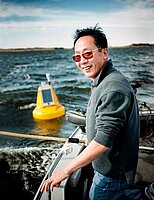Modeling Water Balance and Flows of Sediment and Nutrient in Devils Lake Watershed Using SWAT

Afshin Shabani is a PhD student in Earth System Science and Police program at University of North Dakota. He hold a Master of Science degree in Remote Sensing and Geographic Information System form university of Tehran, Iran, and Bachelor degree in watershed engineering, Gonbad Kavos university, Iran. He is interested in environmental modeling and his present study is focused on monitoring and modeling water quality using satellite image and SWAT model.
Email: Afshin.Shabani@und.edu
Phone: 701-335-3129
Fellow: Afshin Shabani
Advisor: Xiaodong Zhang, Ph.D, Professor, Department of Earth System Science and Policy, North Dakota University.
Modeling Water Balance and Flows of Sediment and Nutrient in Devils Lake Watershed Using SWAT
Devils Lake (DL) has a long history of water level fluctuation. Over the last two decades, the lake level has increased nearly 10 m, flooding the surrounding communities and infrastructure. Over one billion USD has been spent in mitigation measures, including upper basin water management to reduce the runoff, continuing infrastructure protection and developing emergency outlets. Releasing water through emergency outlets is controversial because the Devils Lake water contains a significantly higher concentration of dissolved solids, and particular sulfate, than the surrounding water bodies. The impaired water quality is largely due to the fact that the Devils Lake is a terminal lake, accumulating nutrients, sediment and other dissolved solids entering into the lake from the watershed that has been primarily used for agricultural production. Because of its high salt concentration, the water is not even suitable for irrigating. In this study we develop a comprehensive model simulating the lake level fluctuation and lake water quality along with discharge, sediment and nutrients flux. We chose to use the SWAT model for simulation because of its proven capacity in simulating hydrology and water quality in tributaries and lakes.
Project Objectives:
To achieve the goal, we propose to address the following specific objectives:
- Simulation of discharge and lake water level fluctuation
- Calculating sediment and nutrients flux in upstream, tributaries and lake
- Validating the model outputs using the near-real time buoy measurements of water quality parameters
- Using downscaled Global Circulation Model (GCM) data to predict elevation and nutrients at DL watershed by 2030.
- Evaluating various land use and economic-driven scenarios that can lead to alleviation of flooding and improvement of water quality at DL.
Progress:
We have implemented a SWAT model that is largely successful in simulating flow, TSS, and nutrients in the tributaries and the lakes of the Devils Lake watershed with results that are in general agreement with the measurements. As we introduced earlier, the issues with rising water in Devils Lake are concerned with both quantity and quality. Indeed, the simulation shows that the operation of the two outlets since June 2007 has lowered the lake level by 0.70 m. The average monthly TSS concentrations in Devils Lake watershed tributaries range between ~ 20 to 105 mg/l, similar to the TSS concentration of 21 to 95 mg/l measured for the Sheyenne River.
Significance:
The anticipated results include 1) Modeling discharge and lake water fluctuation; 2) Simulation of water quality over DL basin that can help to detect the source of non-point pollutions and to ameliorate lake water quality degradation; 3) Examining the feasible scenarios that can potentially prevent flood and improve lake water quality.
Peer-Reviewed Journal Papers:
Shabani, A., Zhang, X., and El, M. 2016. Modeling Water Quantity and Quality in the Devils Lake Watershed Using SWAT. Journal of American Water Research Association. In Review.
Conference/Seminar Presentations:
Shabani, A., Zhang, X., and El, M. 2015. Modeling Water Quantity and Quality in the Devils Lake Watershed Using SWAT. SWAT conference, Purdue University (Oral presentation).
Shabani, A., Zhang, X., and El, M. 2016. Modeling Water Quantity and Quality in the Devils Lake Watershed Using SWAT. North Dakota Water Quality Conference, Bismarck (Oral presentation).

Xiaodong Zhang
Earth System Science & Policy
Office: Clifford Hall, Room 300
4149 Campus Road - Stop 9011
Grand Forks, ND 58202-9011
Telephone: 701-777-2490
Email: xiaodong.zhang2@UND.edu


